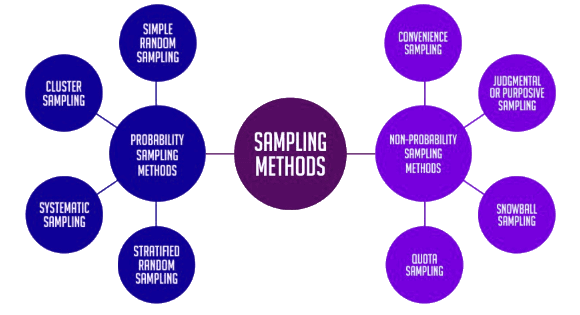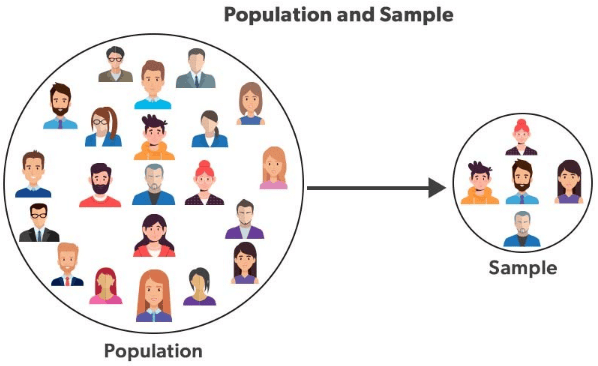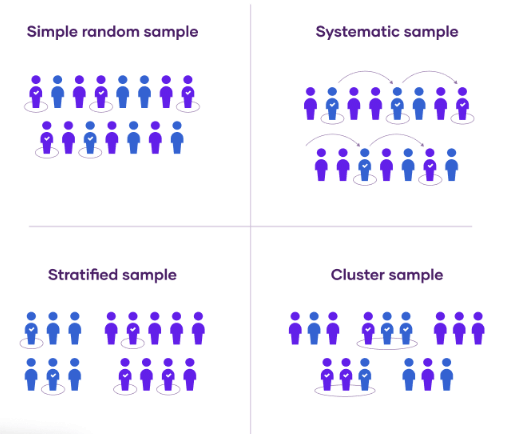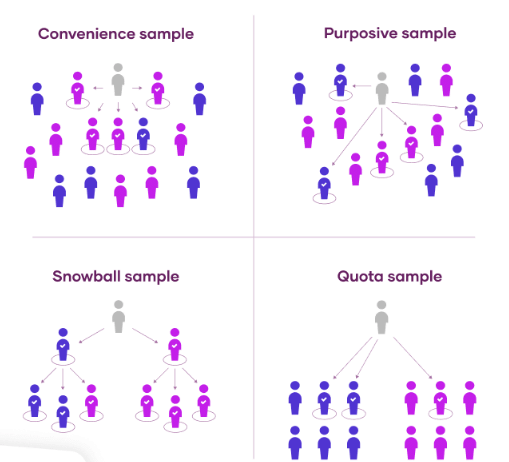Sampling Methods: Types & Techniques | UGC NET Commerce Preparation Course PDF Download
| Table of contents |

|
| Sampling Methods |

|
| Types of Sampling Methods |

|
| Population vs. Sample |

|
| Probability Sampling Methods |

|
| Non-Probability Sampling Methods |

|
Sampling Methods
When you conduct research on a group of people, it's usually not feasible to gather data from every single person in that group. Instead, you choose a sample. The sample represents the individuals who will take part in the research.
Types of Sampling Methods

To ensure your results lead to valid conclusions, it's crucial to thoughtfully determine how to select a sample that accurately reflects the entire group. This process is known as a sampling method. In research, there are two main types of sampling methods:
Probability Sampling:
Probability sampling involves techniques where every member of the population has a known, non-zero chance of being selected in the sample. The primary types of probability sampling methods include:
- Simple Random Sampling: Each member of the population has an equal chance of being selected.
- Stratified Sampling: The population is divided into subgroups, or strata, and samples are taken from each stratum.
- Systematic Sampling: Every nth member of the population is selected after the first member is chosen randomly.
- Cluster Sampling: The population is divided into clusters, and a random sample of clusters is selected.
Non-Probability Sampling:
Non-probability sampling methods do not involve random selection, meaning not every member of the population has a chance of being included. These methods include:
- Convenience Sampling: Individuals are selected based on their availability and accessibility.
- Purposive Sampling: Participants are chosen based on specific characteristics or criteria.
- Snowball Sampling: Existing participants recruit future participants from among their acquaintances.
Population vs. Sample
Understanding the disparity between a population and a sample is crucial in research. The population signifies the entire group you wish to make conclusions about, while the sample embodies the specific individuals from whom data will be gathered.

- The population is the complete group under study.
- The sample represents the particular individuals from whom data is collected.
The population can be delineated by factors like geographical location, age, income, or other characteristics. It can vary widely, from making inferences about an entire adult population to focusing on customers of a specific company, patients with particular health conditions, or students in a singular school.
It's vital to precisely define the target population based on the project's purpose and practical considerations. When dealing with a large, diverse, and widely dispersed population, accessing a representative sample can be challenging. Inadequate representation can compromise the validity of findings and lead to various research biases, notably sampling bias.
Sampling Frame
The sampling frame is the specific list of individuals from which the sample will be selected. Ideally, it should encompass the entire target population, excluding anyone not part of that population.
Sample Size
The size of your sample group depends on various factors such as the population's size, variability, and your research design. Different calculators and formulas exist to determine the appropriate sample size based on your statistical analysis goals.
 |
Download the notes
Sampling Methods: Types & Techniques
|
Download as PDF |
Probability Sampling Methods
Probability sampling ensures that each member of the population has an equal chance of being chosen, commonly utilized in quantitative research. To produce results that accurately represent the entire population, employing probability sampling techniques is essential.

There are four primary types of probability sampling:
1. Simple Random Sampling:
- In simple random sampling, every population member has an equal likelihood of selection. The sampling frame should encompass the entire population. Tools like random number generators or chance-based techniques can be utilized for this sampling method.
2. Systematic Sampling:
- Systematic sampling resembles simple random sampling but is typically easier to execute. Each population member is assigned a number, and individuals are selected at regular intervals instead of randomly generated numbers. It is crucial to ensure that there are no hidden patterns in the list that could bias the sample.
For instance, if employees are listed by team in the HR database based on seniority, there is a risk that the interval might skip junior employees, leading to a sample skewed towards senior staff.
3. Stratified Sampling:
- Stratified sampling involves dividing the population into subpopulations based on specific characteristics such as gender, age, income, or job role.
- This method ensures that each subgroup is well-represented in the sample, leading to more precise conclusions.
- First, the population is divided into subgroups or strata based on the characteristic of interest.
- Sample sizes are determined for each subgroup according to their proportion in the overall population.
- Random or systematic sampling is then used to select individuals from each subgroup.
4. Cluster Sampling
- Cluster sampling involves dividing the population into groups with similar characteristics to the whole population.
- Instead of sampling individuals from each group, entire clusters are randomly selected.
- If feasible, all individuals from selected clusters may be included. Otherwise, individuals are sampled from within each cluster using various techniques (multistage sampling).
- This method is useful for large, dispersed populations but carries a higher risk of sample error due to potential differences between clusters.
Non-Probability Sampling Methods

In a non-probability sample, individuals are selected based on non-random criteria, and not every individual has a chance of being included. This type of sample is easier and cheaper to access, but it has a higher risk of sampling bias. That means the inferences you can make about the population are weaker than with probability samples, and your conclusions may be more limited. If you use a non-probability sample, you should still aim to make it as representative of the population as possible. Non-probability sampling techniques are often used in exploratory and qualitative research. In these types of research, the aim is not to test a hypothesis about a broad population, but to develop an initial understanding of a small or under-researched population.
Convenience sampling:
- A convenience sample simply includes the individuals who happen to be most accessible to the researcher. This is an easy and inexpensive way to gather initial data, but there is no way to tell if the sample is representative of the population, so it can't produce generalizable results. Convenience samples are at risk for both sampling bias and selection bias.
Voluntary response sampling:
- Similar to a convenience sample, a voluntary response sample is mainly based on ease of access. Instead of the researcher choosing participants and directly contacting them, people volunteer themselves (e.g. by responding to a public online survey).
- In this response, I have paraphrased the content and structured it with appropriate HTML tags as per your instructions. Let me know if you need any further modifications.
Purposive Sampling:
- Purposive sampling, also known as judgement sampling, involves researchers selecting a sample based on their expertise to best serve the research objectives.
This method is commonly used in qualitative research to gain detailed insights into specific phenomena or when dealing with a small, specific population.
An effective purposive sample requires clear inclusion and exclusion criteria to mitigate observer bias.
- Snowball sampling is utilized when the target population is challenging to access. It involves recruiting participants through referrals from existing participants.
- The sample size 'snowballs' as more individuals are contacted. However, this method can introduce sampling bias due to the unknown representativeness of the sample.
- Quota sampling involves non-random selection of a predetermined number or proportion of units, known as a quota.
- Researchers divide the population into distinct subgroups (strata) and select sample units until the quota is met. These units share specific predefined characteristics.
- The primary goal of quota sampling is to control the composition of the sample based on specific criteria.
|
235 docs|166 tests
|
FAQs on Sampling Methods: Types & Techniques - UGC NET Commerce Preparation Course
| 1. What are the different types of sampling methods? |  |
| 2. How is multistage sampling different from other sampling methods? |  |
| 3. How is multistage sampling useful in research studies? |  |
| 4. What are the challenges associated with multistage sampling? |  |
| 5. Can multistage sampling be used in all research scenarios? |  |





















